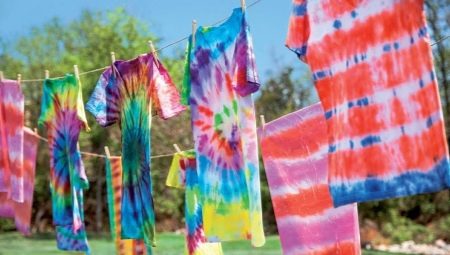For more than 10 centuries, there has been a history of the most ancient type of batik - nodular. The homeland of this art is Indochina. And the word “batik” itself consists of two: “ba” is the fabric, and “teak” is the period (the term is taken from the language used on the island of Java). The name arose due to the unique technology of coloring the material, the basis of which was the use of wax. Now batik is a painting on fabric, wax is not actually used, but variations in the patterning of the pattern have been improved every time.
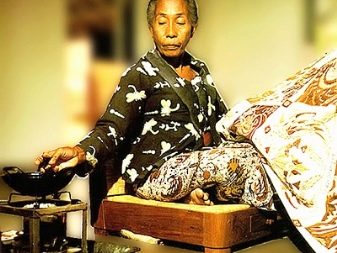

Characteristic
The technology of nodular batik is not difficult. It is similar to other batik directions: the fabric needs to be reserved from contact with the dye composition. Only in a specific situation, it is not the backup compound that is applicable, but ropes, threads, tows with which you can create knots.
First, you need to wrap the fabric, bandage it, make knots on it, and only then it sinks into the paint. Or paint is applied to the fabric with a brush. When the painting process is over, rewound and tied places will remain unpainted. The result is an interesting pattern, its complexity and beauty depend on how well-thought-out nodal technique is. Nodules, by the way, are knitted both manually and with special devices resembling hooks.
The technique of performing batik is simple. It is often shown to children, since they like such handicraft very much: as a rule, guys with the help of nodular batik make themselves rainbow bandanas.
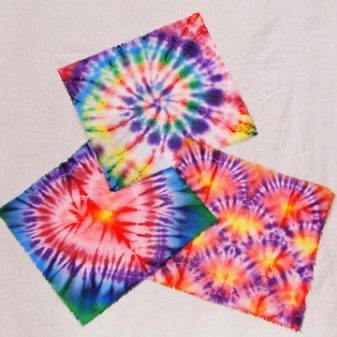
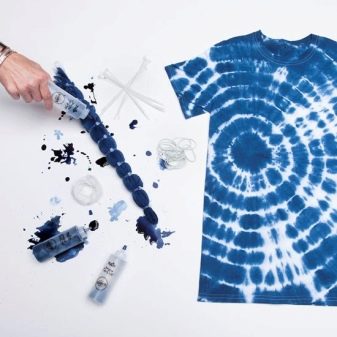
What fabric do you need?
In order for the pattern on the fabric to turn out beautiful, bright, and persistent, you should decide on the fabric itself.
Specialists recommend cotton fabrics:
- calico;
- chintz;
- satin;
- thin sheet.
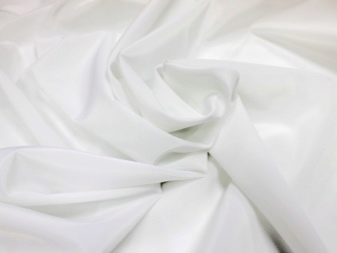
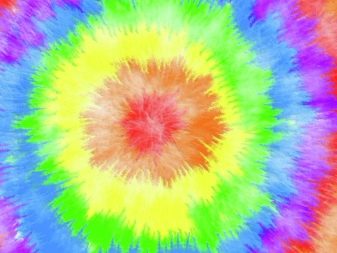
Shades of fabric preferably white or light. It’s good if the material is monophonic, with a rare printed pattern like peas or stripes. It's no secret that manual creativity always tends to save, because there is nothing reprehensible in the use of second-hand fabrics. Subsequently, works in the technique of nodular batik look great, the fabrics of which previously burned out in the sun, lost their brightness.
And only when the experience in the technology of dyeing fabric is confident, sufficient to complicate the technique, we can begin to transform natural silk, viscose, pure wool. But synthetic fabric for batik is not used. Even a fabric interspersed with synthetics will not work. These materials require a fundamentally different working technique, schemes and dyes will be different.
If you do not know these rules, the picture may turn out to be fuzzy, blurry. Aniline dyes can not cope with synthetic fibers, hence the result.

Dyes
Aniline dyes are the main "participant" in batik. They are used for dyeing cotton fabrics. In almost any store of goods for creativity, you can find a fairly wide palette of these dyes. But many lovers of batik are not looking for easy ways, they make dyes on their own.
It is possible - remember what shade gives onion peel or nettle. Natural dyes, of course, are more environmentally friendly, which is what attracts modern admirers of batik.
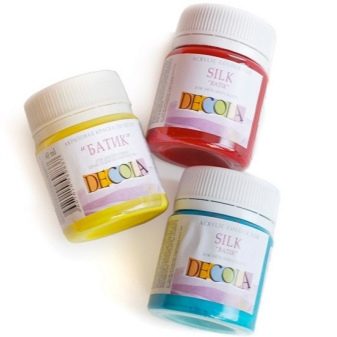
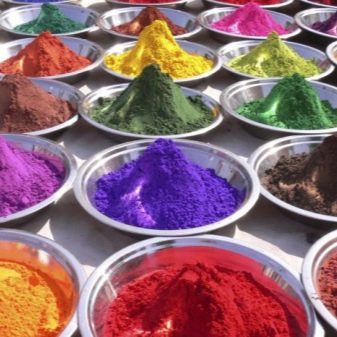
Examples of vegetable dyes:
- red - St. John's wort, buckthorn and hawthorn;
- yellow - potatoes and hazel;
- green - nettle and cuff;
- Orange - celandine;
- blue - blueberries;
- purple - blueberries;
- blue - Ivan da Maria flowers.
You can start with industrial dyes, and when you get the confidence, try to get the paints yourself: you will get a creative natural product.
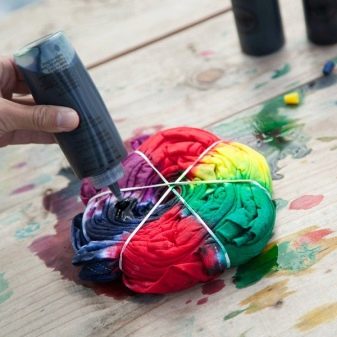

Tools and accessories
The main tool that helps to make the nodules is a thin cord or a strong thread of sufficient reliability. They must prepare the fabric for dyeing. Of the auxiliary composition it should be noted:
- eggshell;
- small pebbles;
- wood chips;
- even small planks;
- clothes pegs;
- traffic jams;
- covers and more.
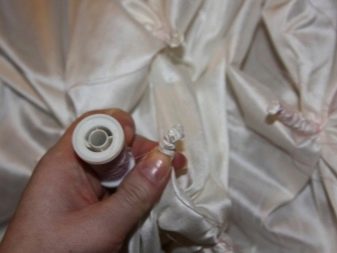
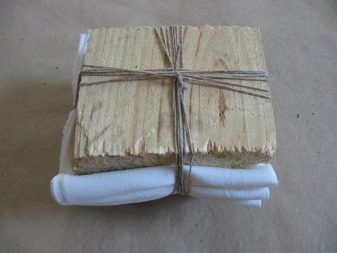
All these tools at hand help create a unique pattern on the fabric. You can not be limited to the proposed list, but come up with your own stamps, copyright. Someone uses baby hair clips, someone caps from felt-tip pens and pens, someone elastic bands-springs.
And you will also definitely need utensils where the most interesting things will be carried out in nodal batik. It should be a container made of glass or ceramic (paints will be diluted in it), an enameled pan (the coloring itself takes place), a container for subsequent rinsing of the fabric, a plastic bottle for storing dye. You need a standard wooden spatula with which you will stir the fabric.
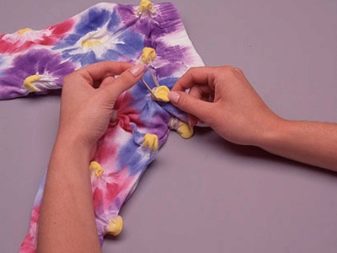

Technology
The presence of special skills, art education, and even a simple ability to draw is not necessary. The principle of nodular batik: each piece of fabric that has not been dyed is tied so that the paint does not get into the nodule. For this we need clothespins, clamps, cords. They do what batik calls tissue redundancy. The fabric can be twisted, folded, stitched, folded.
In this way, reservation and subsequent staining, you can make napkins, tablecloths, clothes, scarves, bandanas, pareo.

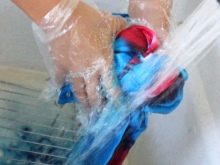
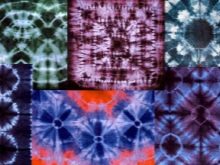
The next stage - staining can be of two types.
- Brush painting. A blank with nodules is placed in a not very deep container, after which a small amount of dye is applied to it. If using multiple colors, apply them alternately. But keep in mind that neighboring colors often mix, a new shade is obtained (not always beautiful). Therefore, think over what and how, in what sequence you paint.
- Immersion staining. Without a brush, you simply dip the fabric into a container of diluted paint. So usually carry out multi-color staining. The process is progressive, slow.
Multicolor staining will be more difficult. On the stretched fabric, the master puts blots, makes stripes and various spots, claiming to be artistic. And after drying, knots, small and large, are knotted on the fabric, after which the fabric is immersed in a darker paint than was used before. The procedure is repeated several times.
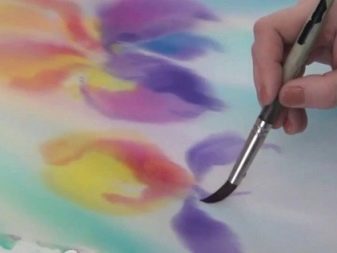
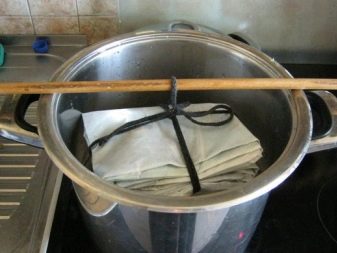
How to fix the composition?
There is an option to use paints “for iron”. The work is first dried, then freed from nodules, ironed on the back side. Then it should be thoroughly rinsed in clean water, so that residual dye is removed. If steam-tightened dyes are used, the fabric is also freed from nodules, painting is fixed with steam. The product should also be rinsed, dried, ironed.
If you use aniline dye and the immersion method, it is possible to fix the dye immediately. It is diluted with hot water in a bowl that can be heated. This water should cover the entire tissue even after boiling, because water is taken 3-4 liters per 100 g of tissue (in dry condition). The blank is placed in a bowl and boiled over a not very large fire. The cotton is boiled for 20 minutes, then it is taken out, 50 g of salt is added to the solution, and the fabric is again boiled for half an hour.
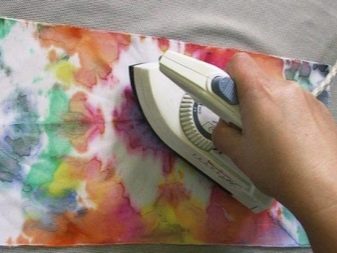
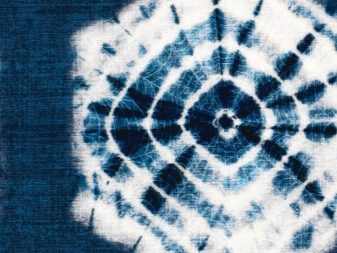
If you dye silk, the process will not differ much, but only instead of salt, vinegar is used. The fabric must be left in solution until its temperature drops to 50 degrees. Then the fabric is washed in warm water, then in cold. Only at this stage are the nodules untied, and the tissue washed again. The fabric is ironed still wet, so that the folds from the knots leave without problems. If you do it this way, re-fixing the color will not be necessary.
Nodal batik is not the most capricious technique, it goes well with others (with cold and hot batik). Often, masters use it as the basis for a floral motif, which is further worked out already using the technique of cold batik. In technology, it is not necessary to use the entire cut, but only part of it. While you are boiling the material, one edge of it can be left unpainted, conveniently fixing it over the dishes for boiling. So, the transition from the colored part to the unpainted will be natural. And then you can manually paint an unpainted fragment.
Those who in the Soviet years “cooked” jeans understand how knots and boiling can achieve a unique clothing design. Try nodular batik, you will like it!
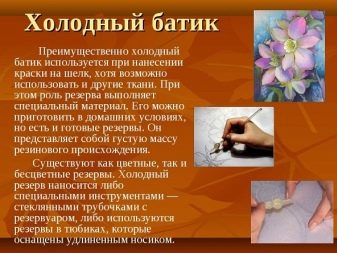

In the next video, you will find a master class on nodular batik (pattern "spiral").
